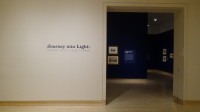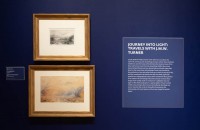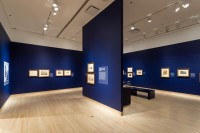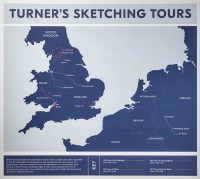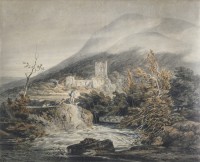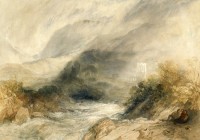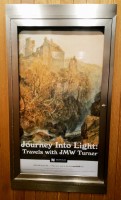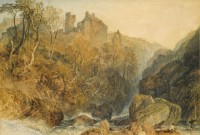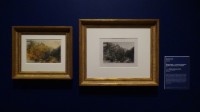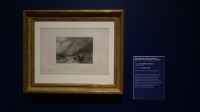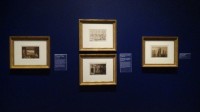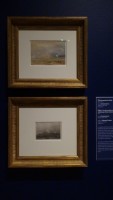The browser will either open the file, download it, or display a dialog.
Journey into Light: Travels with J.M.W. Turner
Indianapolis Museum of Art at Newfields
July 24–December 6, 2020
At a point when many of us continue to face the effects of the global COVID-19 pandemic, this small show at the Indianapolis Museum of Art at Newfields nicely demonstrates the history of our longing for vicarious travel. Journey into Light: Travels with J.M.W. Turner features approximately thirty works on paper in a small room off the European galleries (fig. 1). All the objects included in the exhibition come from the museum’s extensive holdings of Turner material, pulled mostly from the generous gift made by Kurt Pantzer in 1979. Pantzer, one of the largest private collectors of Turner in the 20th century, bequeathed his collection of 3,538 prints, drawings, watercolors, and ephemera to the IMA, making the Midwestern museum an unexpected center for Turner scholarship.
Prior to 2018, rotating exhibitions of the museum’s Turner collection were displayed in the second floor of the Clowes Pavilion, but this space has been closed for the past two years while undergoing extensive renovations. It was therefore welcome news to hear that this small exhibition would be open for six months just as quarantine orders relaxed. Admission to the exhibition is included in the general ticket price, and it is highly recommended that guests purchase their timed tickets in advance through the museum’s website. Gallery guides helpfully control foot traffic to ensure social distancing in the more popular areas of the museum such as the exhibition Edward Hopper and the American Hotel, which runs until October 25th.[1]
Anna Stein, Assistant Curator of Works on Paper, organized the show around the theme of travel, highlighting Turner’s wide-ranging sketching trips and the works he produced for the mass market. The label copy closely linked Turner’s watercolors to specific commissions, an often-overlooked aspect of the way in which he produced his works. The brief introductory gallery text notes that middle-class British arm-chair tourists desired scenes from home and abroad, creating a market that Turner and his publishers were happy to supply (fig. 2). Roughly two-thirds of the works in the exhibition feature scenes from England, Scotland, and Wales while others come from Turner’s more far-flung trips to Italy and Germany. The images chosen for display played off Turner’s aesthetic preferences and strengths. The majority of the works feature rough landscapes, Gothic ruins, and dramatic cliffs and waterfalls that nicely encapsulate Turner’s Romantic style.
The gallery is painted in a vibrant cobalt blue that offsets the soft blues and yellows of Turner’s palette (fig. 3). Stein has organized the exhibition by grouping two to four works together at regular intervals. This allows for a thematic organization as well as ensuring that the small watercolors and prints do not get lost in the expanse of the wall. Along with the twenty-nine hanging works there are also free-standing pedestal cases which include first editions of two of the travel books illustrated by Turner.
A helpful map is located on the left wall as one enters the gallery, tracing four of Turner’s trips between 1794 and 1817 (fig. 4). It is unfortunately restricted to sites in England and Northern Europe even though the gallery includes scenes from his trip to Italy in 1819–20 such as Venice: The Rialto and his trip to Switzerland in 1844 as seen in Lake of Lucerne from Brunnen. Considering the almost constant travels of Turner during his long career, this limitation is understandable.
The exhibition, though not organized chronologically, covers the period from Turner’s teenage years while a student of the Royal Academy through his mid-sixties, when he was a popular and well compensated artist. The earliest work displayed in the gallery is a carefully rendered line drawing of Bath Abbey showing Turner’s early ambitions towards a career as an architect, West Front, Bath Abbey (ca. 1791). Another wonderful, early watercolor by Turner included in the show is Llanthony Abbey, Monmouthshire (ca. 1792; fig. 5). Here the viewer can see hints of Turner’s mature style emerging. The inclusion of two boys contemplating swiftly moving water in the center of the work draws the eye back towards the white Gothic abbey in the center. The tall hills framing the abbey are partially obscured by dense rainclouds, portending Turner’s career-long fascination with atmospheric phenomena. Immediately to the right of this work is another watercolor rendering of the same scene produced forty years later, Llanthony Abbey, Monmouthshire (1834; fig. 6). Turner has retained the roiling water and young fisher boys, though now they huddle underneath a bower on the lower right. In contrast, the spindly bell tower of the abbey has shifted further to the right and now emerges from behind two rolling hills not included in the earlier work. Turner’s later landscape has dissolved into dashes of whites, yellows, greens, and blues. The contrast between the works is illuminating and extremely pleasurable.
One of the anchor objects for this exhibition is the exquisite watercolor Rosslyn Castle (ca. 1820) created to illustrate Sir Walter Scott’s book Provincial Antiquities and Picturesque Scenery of Scotland (1826). Scott was so enamored on the paintings Turner produced, he accepted them in lieu of payment from the publisher and hung them in his house behind a curtain to protect them from fading. A cropped detail of the work is used in the marketing material and for the exhibition web page (fig. 7). Despite the modest size (7 x 10 3/8 in.) of the work, the image captures the grandeur of the ruined castle perched precariously above a jagged ravine and surrounded by boulders and a wild glen (fig. 8). Stein placed the subsequent engraving produced by William Raymond Smith in pendent to the original watercolor (fig. 9). This hanging encourages visitors to compare the two mediums, particularly the soft, diffused lines of Turner’s work against the harder edge and sharp contrast of Smith’s.
The depth of the collection is best demonstrated through the trebling of the image Matlock. Positioned in the far left corner of the room, the grouping features the original watercolor by Turner (1794) and a beautifully hand-colored engraving created by John Walker (printed 1854) flanking a pedestal with the book The Itinerant; A Select Collection of Interesting and Picturesque Views in Great Britain and Ireland Engraved from Original Paintings & Drawings by Eminent Artists, opened to the page featuring the same image engraved by J. Widnell in 1795. Commissioned in 1794 by Copper Plate Magazine, Turner produced eight picturesque landscapes from Derbyshire including this scene of the Matlock bridge. Very different from many of his later works, the scene is pastoral with softly undulating hills receding into the distance and mimicking the rounded barrels of the stone bridge that occupies the center of the image. Here Turner’s palette features soft sage greens and light browns while Walker’s is much more vibrant, relying heavily on emerald green. This display highlights the reproductive technology of the engraving process as well as the continued desire for specific images by the British public. The Walker engraving comes from Turner and Girtin’s Picturesque Views, Sixty Years Since, published three years after the death of Turner and fifty-two years after the premature death of Thomas Girtin. All three works are in excellent condition, and it is particularly interesting to compare the two engravings. Switching between the pedestal and frame, I observed a guest spend more than three minutes carefully registering the similarities and differences between the works.
The other pedestal in the gallery also displays a book, this time the highly ambitious Picturesque Views in England and Wales, published in 1834. This is also one of the few instances when the original drawing or watercolor is not included with the subsequent engravings. Instead, two engravings are positioned together, both created by James Tibbets Willmore. Penmaen Mawr, Caernarvonshire (1834, published 1838) depicts a stone path boarded by sharp, jagged cliffs on the right and a churning sea on the left. A group of dark-clothed figures walk towards the viewer, seemingly impervious to the violence of nature on display. The hanging engraving is marred by some foxing, but a close inspection of the piece reveals Turner’s notes written in pencil across the margins correcting the work (fig. 10). The outcome of Turner’s directions on the proof can then be observed in the finalized publication below, where the engraver has increased the contrast in certain areas. The brief notations evidence the hands-on approach Turner took during the engraving process.
No exhibition featuring the printed works of Turner would be complete without a nod to Turner’s own experiments with reproductive media, namely etching and mezzotint. Issued in fourteen parts during the first decade of the nineteenth century when Turner was barred from traveling the Continent due to the Napoleonic Wars, Turner’s Liber Studiorum was a highly personal project featuring seventy landscapes and seascapes. Hung in the gallery are the Frontispiece (1812) and Calm (1812) on either side of a stacked hanging of the uncolored proof etching of Holy Island Cathedral and the finalized mezzotint over etching of Holy Island Cathedral (both 1808; fig. 11). Turner produced the etchings himself and then would review the proofs before the mezzotint was applied. Turner self-funded the project thereby ensuring complete creative control over the works. The gallery label notes that this personal financial investment was very different than that of the other works shown in the exhibition, most of which were commissioned by patrons or publishers.
My favorite pairing was Turner’s The Pyramids at Gizeh (ca. 1832) and the subsequent 1836 engraving by Edward Finden for William Finden’s and John Murray’s Landscape Illustrations of the Bible (fig. 12). Unlike many of the other landscapes produced by Turner, he never traveled to Egypt and therefore relied on the work of others as inspiration to compose the scene. In this case he was given copies of the drawings produced by Charles Barry, who had traveled to Egypt in 1818. Interestingly Turner misinterpreted Barry’s drawing and added a fourth pyramid to his composition, which was then faithfully reproduced by Finden. The scene itself is dramatic and beautiful. The pyramids emerge from the middle ground on the left half of the paper, their shape hinted at by contrasting shades of blue and brown representing the sky and rocky terrain, respectively. Clusters of mounted figures populate the area in front of the pyramids, stretching across the foreground from right to left and drawing the eye. In the middle ground on the right, a small green oasis with palm trees provides an organic contrast to the looming white pyramids. Beyond the oasis, Turner has hinted at a band of green and blue, likely the Nile River, over which the sun or the moon rises dramatically. Finden’s engraving lacks the atmospheric quality of Turner’s watercolor, but he carefully reproduced all the elements and added shadows and clouds to emulate the drama of the original work. He has embellished two of the staffage figures with the inclusion of billowing smoke, only vaguely hinted at in Turner’s watercolor.
For Turner, depicting the pyramids was a return to an earlier triumph. His monumental painting The Fifth Plague of Egypt, also in the Indianapolis Museum of Art at Newfields’s collection, was his first large-scale history scene and was exhibited to much acclaim in the 1800 Royal Academy exhibition, shortly after his election as Associate Member at the age of 24. Of course, he had even less experience with ancient Egyptian architecture thirty years earlier and modeled the Great Pyramid after the much steeper Piramide di Caio Cestio (Pyramid of Cestius) in Rome. It is also notable that despite its title, the painting appears to show the seventh plague with the figure of Moses standing in a desolate wilderness in the right foreground of the scene, reaching his arms out towards the tenebristically highlighted pyramid that dwarfs the city in the middle ground. Above the white pyramid, roiling storm clouds signal the coming plague of hail and fire. Like much of the European collection, this work is unfortunately currently off view.
The only disappointment with this exhibition is that it has no plans to travel and therefore did not warrant a catalogue. Luckily, many of the pieces featured in this exhibition have been previously published in 1997 in the collection catalogue Turner in Indianapolis.[2] The museum also has a wonderfully comprehensive website which includes high resolution imagery, provenance information, and label text. Hopefully the newly redesigned Clowes Pavilion, tentatively scheduled to reopen in 2021 following three years of construction, will continue to have a dedicated space to host regularly rotating exhibitions of the Turner works on paper.
Kirstin Gotway
PhD student, Art History
University of Illinois
Kgotway2[at]Illinois.edu
[1] Anna Stein is also the curator for this exhibition.
[2] Nota bene Kirstin Gotway is the daughter of Martin F. Krause, emeritus Curator of Prints, Drawings, and Photographs as well as author of Turner in Indianapolis.


